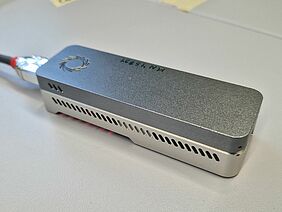Sequencing means determining the DNA - the genetic material in every living organism - in detail, as if you were learning to read a book. Until now, this sequencing was expensive and only available as a service in specialised laboratories. The advantage of the new Oxford Nanopore Sequencing technology is that it is inexpensive and can be established in any laboratory. There is an increasing number of examples from the last two to three years of ONT being used in practice. FiBL is also utilising the technology in various projects.
The method
The device for ONT is about the size of a smartphone. It is connected to a laptop via USB and a prepared environmental sample - e.g. a drop of water from a lake to be analysed - is inserted. The device contains a biomembrane with nanometre-sized pores. The DNA passes through these nanopores, whereby the individual bases of the DNA generate a measurable, individual voltage. These voltages are used to read the base sequence in real time and can be analysed on the computer.
The results are compared with databases containing the DNA sequences of the organisms to be studied. For example it is possible to determine which species live in a body of water by analysing the DNA in a drop of water, or which animals live in a forest based on an air sample.
Applications
Nanopore sequencing allows DNA to be sequenced relatively cheaply, quickly and easily. One application is the detection of antibiotic resistance genes by sampling pig manure. The method also helps in the detection of human pathogens: sampling city air or wastewater makes it possible to recognise and observe pathogens at an early stage. This saves time and is more comprehensive than the previous method of sampling individual affected patients.
At Swiss Federal Institute for Forest, Snow and Lanscape Research WSL, the method is used complementary to conventional practices to determine tree pathogens such as fungi or viruses. At FiBL, the method is used to decode the microbial composition of the soil and fungal genomes. FiBL's plant breeding department is interested in nanopore sequencing to analyse the DNA of wild types and select species that are advantageous for breeding. Another interesting application is the "forensic" detection of the smallest traces of DNA from all organisms (microorganisms, insects, animals) that play a role in an agroecological system, e.g. as beneficial organisms or pollinators.
The symposium
More than 70 people recently attended the Nanopore Sequencing Symposium on 11 April at FiBL Switzerland in Frick. Among them were researchers from various research institutes and universities as well as international visitors from Italy, Spain and Germany. Employees from various cantonal and private service laboratories also took part.
A wide range of research projects using nanopore sequencing were presented. Many of the participants attended the symposium as they are interested in using the method themselves. In addition, employees from the sponsor Microsynth and the manufacturer Oxford Nanopore Technologies answered detailed questions about the method and took requests for improvements.
How to proceed?
The main challenges lie in the methodological processes, which still need to be optimised. In addition, detailed reference databases are needed in order to correctly assign the sequenced DNA to the species. Another problem is the question of whether the DNA found in environmental samples originates from living, active or dead, inactive organisms. Despite these hurdles, interest in nanopore sequencing in research is growing and further research results are eagerly awaited.
Further information
Contact
Links
nanoportech.com: Oxford Nanopore Technologies website




